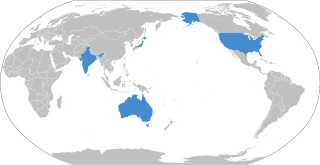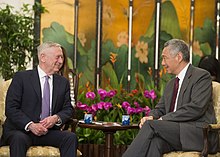
Singapore maintains diplomatic relations with 189 UN member states. The three exceptions are the Central African Republic, Monaco and South Sudan.

The International Institute for Strategic Studies (IISS) is an international research institute or think tank focusing on defence and security issues. Since 1997, its headquarters have been at Arundel House in London. It has offices on four continents, producing data and research on questions of defence, security and global affairs, publishing publications and online analysis, and convening major security summits. The Guardian newspaper has described the IISS as ‘one of the world’s leading security think tanks.’

The Shanghai Cooperation Organisation (SCO) is a Eurasian political, economic, international security and defence organization established by China and Russia in 2001. It is the world's largest regional organization in terms of geographic scope and population, covering approximately 80% of the area of Eurasia and 40% of the world population. As of 2021, its combined GDP was around 20% of global GDP.
There are two annual conferences that go by the title of the Asia Security Conference. The oldest of these is held by the Indian think tank Institute for Defence Studies and Analyses (IDSA) in New Delhi, India. This conference brings together globally renowned scholars who interact with senior members of IDSA as well as senior members of the Indian Government. The 12th Annual Asian Security Conference was hosted by IDSA from 11 to 13 February. These conferences are by invitation only. At the 2010 Conference, the Indian Defence Minister and Indian Defence Secretary both played key roles. The conference annually explores issues of security affecting South Asia. Attendees for the 2010 Conference included senior academics from the United States, Pakistan, Russia, Iran, India, and the United Kingdom, among others. Notable names included G. John Ikenberry, and Aaron Friedburg from Princeton, Summit Ganguly from the Indiana University, John Geis from Air University.

The ASEAN Summit is a biannual meeting held by the members of the Association of Southeast Asian Nations (ASEAN) in relation to economic, political, security, and socio-cultural development of Southeast Asian countries. In addition, it serves as a prominent regional (Asia) and international (worldwide) conference, with world leaders attending its related summits and meetings to discuss various problems and global issues, strengthening co-operation, and making decisions. The summit has been praised by world leaders for its success and ability to produce results on a global level.

Shangri-La Hotel, Singapore is a five-star deluxe hotel located on Orange Grove Road, off Orchard Road, Singapore.

The East Asia Summit (EAS) is a regional forum held annually by leaders of, initially, 16 countries in the East Asian, Southeast Asian, South Asian and Oceanian regions, based on the ASEAN Plus Six mechanism. Membership expanded to 18 countries including Russia and the United States at the Sixth EAS in 2011. Since its establishment, ASEAN has held the central role and leadership in the forum. EAS meetings are held after the annual ASEAN leaders' meetings, and plays an important role in the regional architecture of Asia-Pacific. The first summit was held in Kuala Lumpur, Malaysia on 14 December 2005.

As of 2010, the Association of Southeast Asian Nations (ASEAN) has 10 member states, one candidate member state, and one observer state.
The East Asian Community (EAC) is a proposed trade bloc for the East and Southeast Asian (ESEA) countries that may arise out of either ASEAN Plus Three or the East Asia Summit (EAS).

The Act East policy is an effort by the government of India to cultivate extensive economic and strategic relations with the nations of Southeast Asia to bolster its standing as a regional power and a counterweight to the strategic influence of the People's Republic of China. Initiated in 1991, the Look East policy by Indian government marked a strategic shift in India’s perspective of the world. It was developed and enacted during the government of Prime Minister Narsimha Rao (1991–1996) and rigorously pursued by the successive administrations of Atal Bihari Vajpayee (1998–2004) and Manmohan Singh (2004–2014).

The China–Japan–South Korea trilateral summit is an annual summit meeting attended by the People's Republic of China, Japan and South Korea, three major countries in East Asia and the world's second, fourth and 12th largest economies. The first summit was held during December 2008 in Fukuoka, Japan. The talks are focused on maintaining strong trilateral relations, the regional economy and disaster relief.
Singapore International Energy Week (SIEW), formerly called the International Energy Week, is an annual week-long energy conference comprising several exhibitions, workshops, and networking sessions focused on fundamental issues within the energy industry. Held since 2008, it is organized by the Energy Market Authority.

In international relations, defence diplomacy, refers to the pursuit of foreign policy objectives through the peaceful employment of defence resources and capabilities.
The Singapore Institute of International Affairs (SIIA) is a Singaporean research institute and think tank which focuses on international relations, especially in ASEAN and the Asia-Pacific (APAC). The Institute conducts research, hosts events, and plans conferences that deal with pressing issues in international affairs. It is the oldest think tank in Singapore, being founded in 1961.

The Quadrilateral Security Dialogue (QSD), commonly known as the Quad, is a strategic security dialogue between Australia, India, Japan and the United States that is maintained by talks between member countries. The dialogue was initiated in 2007 by Japanese Prime Minister Shinzo Abe, with the support of Australian Prime Minister John Howard, Indian Prime Minister Manmohan Singh and U.S. Vice President Dick Cheney. The dialogue was paralleled by joint military exercises of an unprecedented scale, titled Exercise Malabar. The diplomatic and military arrangement was widely viewed as a response to increased Chinese economic and military power.
The foreign policy of the Modi government is associated with the policy initiatives made towards other states by the current government of India after Narendra Modi assumed the office of prime minister on May 26, 2014.
The Fourteenth East Asia Summit was held in Bangkok, Thailand on November 4, 2019. The East Asia Summit is an annual meeting of national leaders from the East Asian region and adjoining countries. EAS has evolved as forum for strategic dialogue and cooperation on political, security and economic issues of common regional concern and plays an important role in the regional architecture.
The Fifteenth East Asia Summit was held in Hanoi, Vietnam on November 14, 2020. The East Asia Summit is an annual meeting of national leaders from the East Asian region and adjoining countries. EAS has evolved as forum for strategic dialogue and cooperation on political, security and economic issues of common regional concern and plays an important role in the regional architecture.
The Sixteenth East Asia Summit was held in Bandar Seri Begawan, Brunei on October 26–27, 2021. The East Asia Summit is an annual meeting of national leaders from the East Asian region and adjoining countries. EAS has evolved as forum for strategic dialogue and cooperation on political, security and economic issues of common regional concern and plays an important role in the regional architecture.














